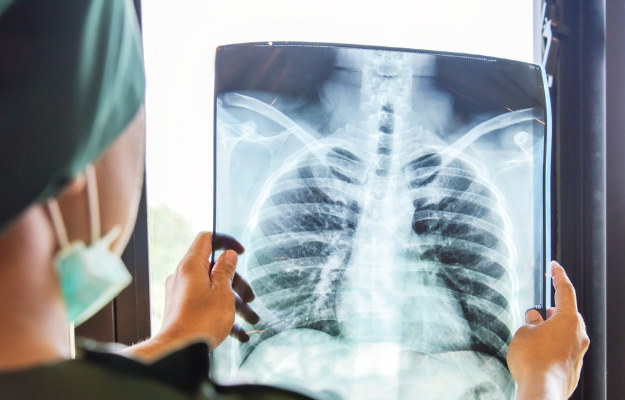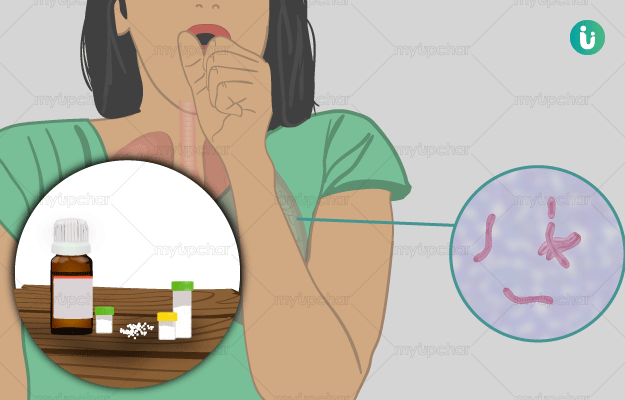Tuberculosis, also known as kshayaroga or rajyakshma, is a wasting disease characterised by various symptoms such as fatigue, low-grade fever, sweating at night, loss of appetite and weight loss. Other symptoms may also appear depending on the organ involved. TB most commonly affects lungs and presents symptoms such as fever in the evening, cough, hoarseness in the voice, and night sweats along with appetite loss and weight loss, pain in the chest, and a burning sensation in palms and the soles of the feet.
Ayurvedic treatment procedures that are recommended for tuberculosis include snehana (oleation), swedana (sudation or sweat therapy), vamana (medical emesis), and virechana (purgation). However, these procedures are only effective in individuals with aggravated doshas and in those who are strong enough to tolerate these therapies. Shodhana karma (purification therapies) should not be used in weak individuals, and they should be very mild even when used in strong individuals with tuberculosis. This is because there is kshaya (depletion) of all seven dhatus in tuberculosis, So, brimhan (nourishing) treatment should be given to strengthen the body. However, care should be taken that dhatu agni is not affected.
The various herbs used in the management of tuberculosis are vidarikand (Indian kudzu), brahmi (waterhyssop), rasonam (garlic), yashtimadhu (mulethi), ashwagandha (Indian ginseng) and guduchi (giloy, heart-leaved moonseed). Medicines that are described in Ayurveda for the management of tuberculosis are eladi churna, sitopaladi churna, chitraka-haritaki, mahalaxmivilasa rasa, chyawanprashavaleha, draksharishta, dhanvantara gutika, bhringrajasava, swarna malini vasanta, madhumalini vasanta and vasanta kusumakar.
- Ayurvedic view of tuberculosis
- Ayurvedic treatment for tuberculosis
- Ayurvedic herbs and medicines for tuberculosis
- Dietary and lifestyle changes for tuberculosis patient as per ayurveda
- How effective are ayurvedic medicines and treatments for tuberculosis
- Side effects and risks of ayurvedic medicine and treatments for tuberculosis
- Takeaway
Ayurvedic view of tuberculosis
As per Ayurveda, rajyakshma develops in the following manner:
- Dhatukshaya tissue loss initiates rajyakshma.
- It is followed by metabolic dysfunctioning of the body due to which meda (adipose tissue), rasa (tissue fluids), rakta (blood), mamsa (muscle) and shukra (generative tissue) dhatus are depleted.
- This leads to ojokshaya (loss of immunity) and, ultimately, infection by pathogenic microorganisms, thus causing rajyakshma.
Ayurvedic treatment for tuberculosis
- Snehana
- This process involves massage with warm medicated oils infused with the properties of herbs to treat the aggravated doshas.
- It helps in liquefying and dislodging ama (toxins) from the smallest channels of the body.
- Swedana
- Swedana involves different procedures to induce sweating. It also helps eliminate ama and balance doshas.
- The various types of swedana are:
- Tapa (fomentation): It involves the use of a metal object, heated cloth or warm hands to provide heat to the body.
- Upanaha: This procedure involves the use of a hot poultice consisting of various herbs based on the aggravated dosha.
- Ushma: Ushma refers to the use of warm steam created by boiling the appropriate herbs depending on the dosha that need to be balanced.
- Dhara: It involves pouring of warm medicated liquid over the body.
- Vamana
- In vamana procedure, medicinal herbs and their combinations are taken to induce vomiting, which helps in clearing ama from the body and balancing doshas. It also helps to eliminate mucus from naadis (channels) and chest.
- The two different types of herbs are used in vamana- vamaka and vamanopaga. Vamaka herbs induce vomiting and vamanopaga herbs enhance the effects of vamaka herbs.
- Vamana is not recommended in pregnant women, children, and weak and debilitated individuals.
- Virechana
- In virechana karma. laxative herbs are administered orally to stimulate the evacuation of the bowel. Just like vamana, virechana also cleanses ama. The commonly used herbs for virechana are senna, aloe and rhubarb.
- It is helpful in eliminating the aggravated pitta from gall bladder, liver and small intestine. It is also effective in the management of kapha diseases as it removes the excess phlegm from the body. Virechana is not recommended in vata disorders.
- It should always be given under the guidance of an Ayurvedic physician. It is counterindicated in case of weakness.
Ayurvedic herbs and medicines for tuberculosis
Ayurvedic herbs for tuberculosis
- Vidarikand
- Vidarikand acts on the digestive and reproductive systems and has tonic, nutritive, rejuvenating and anti-inflammatory properties.
- It helps in increasing weight in weak and debilitated individuals. Since weight loss is one of the major symptoms of TB, this herb is quite effective in improving health in TB patients. Vidarikand is also used in the management of enlargement of liver and spleen.
- This herb can be taken in the form of a confection, powder, decoction and milk decoction.
Are you also troubled by obesity and are not able to lose weight even after a lot of efforts, then start using myUpchar Ayurveda Medarodh Weight Control Tablet today and control your weight.
- Brahmi
- Brahmi acts on the nervous, circulatory, respiratory, reproductive, digestive and excretory systems and has numerous therapeutic effects.
- It is an excellent brain tonic, which rejuvenates brain cells and nerves. Brahmi cleanses and nourishes the immune systems, purifies blood and is thus useful in the management of cough, fever and bronchitis, which are the commonly associated symptoms of tuberculosis.
- Brahmi can be used in the form of ghee (clarified butter), oil, powder, infusion and decoction.
- Rasonam
- Rasonam acts on various systems of the body including the respiratory, nervous, circulatory, reproductive and digestive systems.
- It has anthelmintic, antiparasitic, antibacterial, antispasmodic, carminative (relieves flatulence), expectorant (expels phlegm), rejuvenating and stimulant actions. Garlic opens naadis and helps in the removal of ama from blood and lymph, rejuvenates the bone and nerve tissue, prevents and treats microbial infections of lungs and bronchi, and treats vata fever. Thus, it is highly effective in the management of tuberculosis.
- Rasonam can be used in the form of infusion, powder, juice and medicated oil. The infusion of garlic should not be boiled.
- Yashtimadhu
- Yashtimadhu pacifies vata, pitta and kapha and helps in the elimination of excess kapha from the body. It promotes longevity, strengthens the body and has healing properties, thus proving efficacious in the treatment of tuberculosis.
- It is useful in the management of bleeding, throat irritation, bronchitis and exhaustion. and is most commonly taken in the form of a powder.
- Ashwagandha
- Ashwagandha acts on the nervous, respiratory and reproductive systems and has immune-boosting, anti-inflammatory and rejuvenating properties.
- This herb has been used in Ayurveda for thousands of years for its stress-reducing and healing properties.
- It is an ingredient of chyawanprashavaleha, a well-known immunity boosting medicine which is used in the management of cold, cough, and tuberculosis.
- This herb is commonly used as add-on therapy to conventional medicine as it helps relieve the symptoms of tuberculosis. Being an immunity boosting herb, it prevents microbial infections.
Discover the versatility of Ashwagandha – for stress, vitality, and well-being. Elevate your life naturally. Order now for a holistic wellness experience.Urjas Ashwagandha Tablet by myUpchar Ayurveda
- Guduchi
- Guduchi mainly acts on the circulatory and digestive systems. It is one of the few immune-boosting herbs that can pacify all three doshas and is often used in combination with shilajatu (asphaltum).
- In addition to tuberculosis, guduchi is useful in the management of pitta diseases, jaundice, malarial fever, constipation, gout and chronic rheumatism. It treats fever, clears toxins from the body, and reduces inflammation and pain.
- Guduchi can be used in the form of powder and extracts.
Ayurvedic medicines for tuberculosis
- Eladi churna
- Eladi churna consists of cardamom, cinnamon bark and leaves, nagakesara (Indian rose chestnut), maricha (black pepper), pippali (long pepper) and shunthi (dried ginger).
- It has digestive, carminative and anti-inflammatory properties. It is useful in the management of indigestion, cough, bronchitis, inflammation of the throat and chest, and loss of appetite. All of these symptoms are also associated with tuberculosis, due to which eladi churna is beneficial in the management of tuberculosis.
- Sitopaladi churna
- This powder preparation is made from vanslochan (bamboo resin), cinnamon, long pepper and cardamom.
- It has anti-inflammatory, digestive, expectorant, sedative (induces sleep), anti-infective and carminative properties, which help in the management of tuberculosis.
- It can be used with ghee or honey for treating cough and bronchitis.
- Chitraka haritaki
- Chitraka haritaki is prepared from of chitraka (leadwort), amalaki (Indian gooseberry), guduchi, dashmoola (10 roots), jaggery, haritaki (chebulic myrobalan), trikatu (a combination of the three acrids – pippali, shunthi and maricha), cinnamon bark and leaf, cardamom and honey.
- This medicine has digestive, carminative and expectorant properties. It increases appetite and is used in the management of tuberculosis, cough and lower abdominal obstruction.
- Mahalaxmivilasa rasa
- Mahalaxmivilasa rasa is prepared from several components including bhasmas (calcined preparations) of abhraka (mica), tamra (copper), vanga (tin), mauktik (pearl), suvarna (gold), raupya (silver) and naga (lead).
- This preparation helps increase immunity and strength in tuberculosis patients thus helping improve symptoms and prevent further infections.
- It is also useful in treating headaches caused due to vitiated vata dosha or due to ringing of the ears and weakness due to long-standing vata diseases.
- Chyawanprashavaleha
- Chyawanprashavaleha consists of large size, fresh and ripe amalaki, honey, sesame oil, sugar candy, dashmoola, pippali, guduchi, haritaki, musta (nutgrass), punarnava (red hogweed) and cardamom. Dry fruits can be used if fresh fruits are unavailable.
- It is a mild expectorant and is useful in the management of debility and cough, which are the most common symptoms of tuberculosis. It is also effective in the treatment of bronchitis and asthma.
- Draksharishta
- Draksharishta consists of several ingredients such as twak (cinnamon), ela (cardamom), tejpatra (Indian bay leaf), date fruits, chandan (sandalwood), lavang (clove), pippali (long pepper), honey, raisins and sugar.
- This medicine is used as a restorative, cardiac tonic and mild laxative. It has appetising and digestive properties and is thus helpful in the management of loss of appetite in tuberculosis patients. It is also effective in the treatment of haemorrhoids.
- Dhanvantara gutika
- Some ingredients of dhanvantara gutika are shunthi, chirayata (bitterstick), cardamom, haritaki, Indian nightshade root and cumin.
- It is used as a cardiac tonic and an expectorant and is helpful in the management of tuberculosis, cough and bronchitis. It is also useful in treating weakness of the heart and pneumonia.
- Bhringrajasava
- This Ayurvedic formulation consists of bhringraj (bhangra), haritaki, pippali, twak, tejpatra, nagakesara, lavang (clove), cardamom, jatiphal (nutmeg) and jaggery.
- Bhringrajasava has nutritive, tonic, antibacterial and rejuvenating properties. It can correct and restore the metabolic and digestive fire in body tissues.
- This medicine also improves and stimulates immune function.
- Madhumalini vasanta
- This formulation consists of various ingredients including cinnabar, black pepper, lime juice and white pepper.
- It is used in the management of cough, chronic fever and tuberculosis.
- Vasanta kusumakar
- Swarnamalini vasanta
- The major components of swarnamalini vasanta are swarna bhasma, mauktik bhasma, maricha and lime juice.
- It is effective in the management of tuberculosis, cough and chronic fever.
Dietary and lifestyle changes for tuberculosis patient as per ayurveda
Do’s
- Include a red variety of rice and the seeds of barley in your diet.
- Add fruits like pomegranate, amalaki and mango in your diet.
- Consume goat’s milk and scented water.
- Take moderate amounts of wine, but follow necessary precautions while using it.
- Include the meat of goat, deer, crab and wild animals in the diet.
Don’ts
- Do not consume fried or fatty food.
- Do not eat certain vegetables like brinjal and bitter gourd as they are harmful in case of tuberculosis.
- Do not eat bilwa (golden apple) fruit.
- Avoid excessive sexual intercourse and daytime sleep.
- Avoid extreme emotions like anger.
How effective are ayurvedic medicines and treatments for tuberculosis
A clinical study indicating the importance and effectiveness of bhringrajasava in the treatment of tuberculosis reported that this formulation is a valuable adjunct to DOTS (directly observed treatment, short course chemotherapy) therapy. It is an immune booster, providing protection from invading microorganisms. Bhringrajasava also protects the liver from the toxic effects of DOTS therapy. It was concluded that adjunctive treatment with bhringrajasava along with DOTS treatment shows a marked improvement in the clinical condition of individuals with tuberculosis.
Side effects and risks of ayurvedic medicine and treatments for tuberculosis
Ayurvedic treatments and medicines are very safe when taken under the supervision of an experienced doctor. However, depending on individual prakriti, certain precautionary measures have to be taken into consideration for efficacious treatment and to prevent worsening of the condition. For example,
- Purification procedures should not be used for very weak individuals
- Brahmi should be taken with caution as large doses may lead to headache and itching
- Rasonam should not be taken in case of hyperacidity and excessive pitta
- Yashtimadhu therapy can lead to sodium and water retention and cause hypertension when taken for more than 6 weeks
Takeaway
Tuberculosis is a contagious disease that can spread easily through air. Development of antibiotic-resistant strains of tuberculosis bacilli has made it difficult for conventional medicine to completely treat this disease. Ayurveda describes many age-old medicines and techniques that can help manage the condition better. DOTS therapy is widely used in the treatment of tuberculosis, but it has several potential side effects like liver toxicity. Ayurvedic herbs and medicines can be used as an adjunct to newer therapies, which helps them work faster and more effectively. Ayurvedic herbs protect the liver when given alongside DOTS. Also, Ayurvedic herbs and medicines boost immune function and strengthen the overall functioning of your body, thus promoting recovery.
Find Ayurvedic Doctor in cities
Doctors for Ayurvedic medicine, treatment and remedies for Tuberculosis

Dr. Megha Sugandh
Ayurveda
6 Years of Experience

Dr. Nadeem
Ayurveda
3 Years of Experience

Dr.Ashok Pipaliya
Ayurveda
12 Years of Experience

Dr. Harshaprabha Katole
Ayurveda
7 Years of Experience
References
- National Institute of Indian Medical Heritage (NIIMH). Rājayakṣmā. Central Council for Research in Ayurvedic Sciences (CCRAS); Ministry of AYUSH, Government of India.
- Rajiv Gandhi Government Post Graduate Ayurvedic College. Kayachikitsa. Paprola, Himachal Pradesh. [Internet].
- Anshu Malviya1, Radha Gupta, Sharad M. Porte. [link]. International Journal of Ayurveda and Pharma Research, 2016;4(2):46-52.
- Jitendra Varsakiya, Divyarani Kathad, Rahul Shingadiya. [link]. World Journal of Pharmaceutical Research, Vol 7, Issue 11, 2018..
- Vaidya Bhagwan Dash. Handbook of Ayurveda .Concept Publishing Company (1987) : Delhi, India.
- The Indian Medical Practitioners' Co- operative Pharmacy and stores Ltd. Vaidya Yoga Ratnavali . Adyar, Madras-20.
- Sathya N. Dornala, Snehalatha S. N. Dornala. Clinical Efficacy of Bhringarajasava as Naimittika Rasayana in Rajayakshma with special reference to Pulmonary Tuberculosis. An International Quarterly Journal of Research in Ayurveda, Oct-Dec 2012 Vol 33 Issue 4.
- Prof. G.S. Lavekar. Classical Ayurvedic Prescriptions for Common Diseases . Central Council for Research in Ayurveda and Siddha. Department of AYUSH, Ministry of Health & Family Welfare, Government of India.














